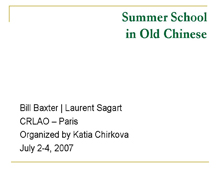Chapitres
- Finals93'29"
- Discussion55'42"
Notice
Finals
- document 1 document 2 document 3
- niveau 1 niveau 2 niveau 3
Descriptif
This presentation introduces the combinations of main vowel and coda Baxter and Sagart reconstruct for Old Chinese, the main factors which influence their subsequent development (whether the syllable is type A or type B, whether or not there is an *-r- before the main vowel, whether or not a suffix *-s is present. Then there is a survey of the main processes by which Old Chinese finals develop into their Middle Chinese reflexes, with examples of each type of development.
Intervention / Responsable scientifique
Thème
Dans la même collection
-
Old Chinese Structure
SagartLaurentFocuses on the structure of Old Chinese words, distinguishing between roots and affixes. Root structure is described as a sequence of positions or slots, some obligatorily, others optionally filled.
-
Sino-Tibetan and Beyond
SagartLaurentSino-Tibetan and beyond discusses important issues in Sino-Tibetan comparison, such as: the A/B distinction, uvulars, presyllables and lenition, morphology; also discusses the evidence for relating
-
Onsets
SagartLaurentThe main issues in the reconstruction of Old Chinese word onsets are discussed. In particular: the A/B distinction and uvulars.
-
Overview
BaxterBillA summary of what Baxter and Sagart mean by Old Chinese, what evidence can be used to reconstruct it, our methodological assumptions, and a brief summary of the history of research on this topic.
-
Lines of Evidence
BaxterBillThis presentation focuses largely on the introduction of Old Chinese linguistic reconstruction and Chinese palaeography. It describes a traditional framework widely taught to and used by
Avec les mêmes intervenants et intervenantes
-
Lines of Evidence
BaxterBillThis presentation focuses largely on the introduction of Old Chinese linguistic reconstruction and Chinese palaeography. It describes a traditional framework widely taught to and used by
-
Overview
BaxterBillA summary of what Baxter and Sagart mean by Old Chinese, what evidence can be used to reconstruct it, our methodological assumptions, and a brief summary of the history of research on this topic.


